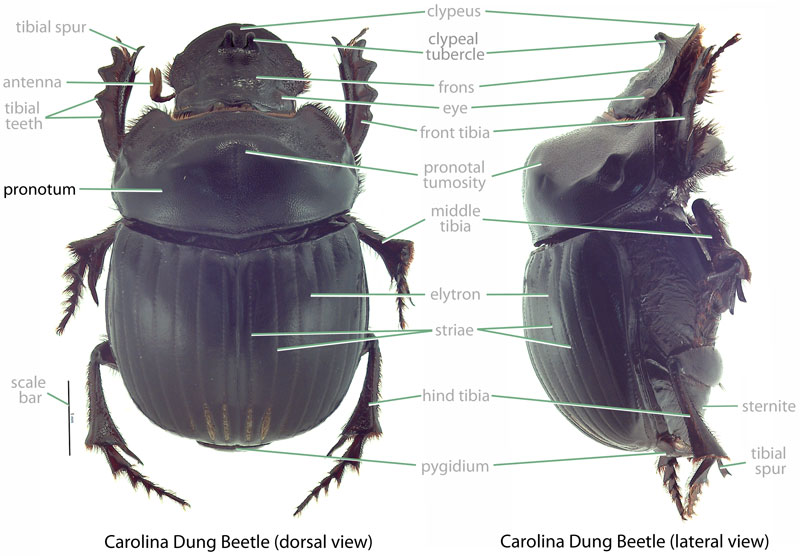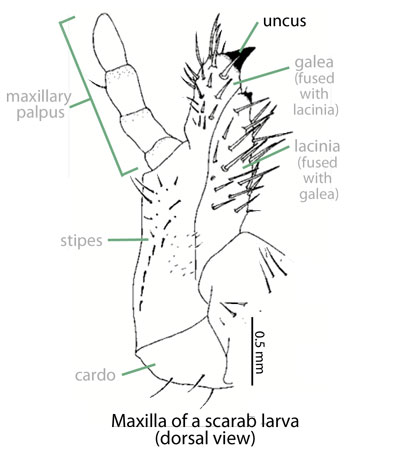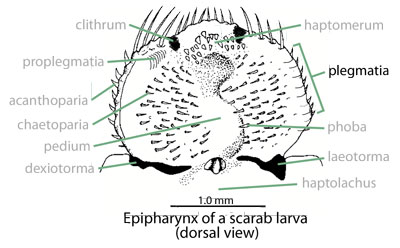Pest
plate-faced beetle
Family: Scarabaeidae Subfamily: Dynastinae Genus: Temnorhynchus Species: Temnorhynchus retusus (Fabricius, 1781)
none available
Total body length 16.0–20.0 mm (0.63–0.79 in). Body wide, oval-shaped. Color black. Head lacking horns or tubercles; with distinctive cranial "face" plate; cranial plate notched medially, more deeply notched in males than females. Pronotumpronotum:
the dorsal surface of the thorax
 with anteromedialanteromedial:
with anteromedialanteromedial:
middle of the front portion
concavity in male; female pronotumpronotum:
the dorsal surface of the thorax
 lacking concavity; pronotumpronotum:
lacking concavity; pronotumpronotum:
the dorsal surface of the thorax
 lacking horns or tubercles. ElytraElytra:
lacking horns or tubercles. ElytraElytra:
the hardened and chitinous wing-cover of a beetle that protect and overlie the flight wing
weakly striated.
Undescribed. For Dynastinae (Ritcher, 1966Ritcher, 1966:
Ritcher P. 1966. White grubs and their allies: a study of North American scarabaeoid larvae. Oregon State University Monographs, Studies in Entomology 4: 1-219.): Grub C-shaped, not hump-backed, cylindrical, whitish. Maxillamaxilla:
set of paired mouthparts located posterior to the mandibles
with galeagalea:
outer branch or lobe of the maxilla
 and lacinialacinia:
and lacinialacinia:
inner portion of the maxilla fused or nearly so. Lacinialacinia:
fused or nearly so. Lacinialacinia:
inner portion of the maxilla of maxillamaxilla:
of maxillamaxilla:
set of paired mouthparts located posterior to the mandibles
with 3 well developed unciunci:
in scarab larvae, a hooked process on the distal margin of the maxilla
 . Maxillary stridulatory teeth truncatetruncate:
. Maxillary stridulatory teeth truncatetruncate:
appearing cut-off or suddenly shortened
. Legs 4-segmented. Anal opening transversetransverse:
extending horizontally across a surface
, straight or slightly curved. PlegmatiaPlegmatia:
in scarab larvae, a paired, lateral region with a somewhat sclerotized surface bordered by marginal spines with acanthoparia
 absent.
absent.
Africa. This species is best known from southern Africa, where it has been recorded in South Africa, Namibia, and Lesotho. Isolated records also exist from Sudan, Eritrea, and Tanzania (Krell, 1993Krell, 1993:
Krell F. 1993. Phylogenetisch-systematische Revision des Genus Temnorhynchus Hope, 1837 (Coleoptera: Scarabaeoidea: Melolonthidae: Dynastinae: Pentodontini). 1. Teil: Phylogenetische Analyse, mit Anmerkunge zur phylogenetisch-sytematischen Methodologie. Beiträge zur Entomologie 43: 237–318.).
Adults and larvaelarvae:
the immature form of an insect; in scarabs, also called grub or white grub; preceded by the egg stage, followed by the pupal stage
 of Temnorhynchus retusus are associated with grasses (Krell and Hangay, 1998Krell and Hangay, 1998:
of Temnorhynchus retusus are associated with grasses (Krell and Hangay, 1998Krell and Hangay, 1998:
Krell F, Hangay G. 1998. The African rhinoceros beetle Temnorhynchus retusus (Fabricius) established in eastern Australia (Coleoptera: Scarabaeidae: Dynastinae). Australian Journal of Entomology 37: 312–314. full text (accessed 2015)). In Hawaii, adults have been found on the saline-tolerant turf species, seashore paspalum (Paspalum vaginatum) (Jameson et al., 2009Jameson et al., 2009:
Jameson M, Oishi D, Ratcliffe B, McQuate G. 2009. Two additional invasive scarabaeoid beetles (Coleoptera: Scarabaeidae: Dynastinae) in Hawaii. Proceedings of the Hawaiian Entomological Society 41: 25–30. full text (accessed 2015)). In South Africa, this species has been recorded damaging potatoes (Visser and Stals, 2012Visser and Stals, 2012:
Visser D and Stals R. 2012. Temnorhynchus coronatus (Fabricius) (Scarabaeidae: Dynastinae), potentially a pest of sweet potato in South Africa. African Entomology 20: 402–407. DOI: 10.4001/003.020.0222).
Poorly known. In Australia, adults of Temnorhynchus retusus are most abundant in September (Jameson et al., 2009Jameson et al., 2009:
Jameson M, Oishi D, Ratcliffe B, McQuate G. 2009. Two additional invasive scarabaeoid beetles (Coleoptera: Scarabaeidae: Dynastinae) in Hawaii. Proceedings of the Hawaiian Entomological Society 41: 25–30. full text (accessed 2015)) and are often found in or near watered, grassy areas in suburban and urban settings (Krell and Hangay, 1998Krell and Hangay, 1998:
Krell F, Hangay G. 1998. The African rhinoceros beetle Temnorhynchus retusus (Fabricius) established in eastern Australia (Coleoptera: Scarabaeidae: Dynastinae). Australian Journal of Entomology 37: 312–314. full text (accessed 2015)). Both larvaelarvae:
the immature form of an insect; in scarabs, also called grub or white grub; preceded by the egg stage, followed by the pupal stage
 and adults of this species appear to feed upon grasses (Krell and Hangay, 1998Krell and Hangay, 1998:
and adults of this species appear to feed upon grasses (Krell and Hangay, 1998Krell and Hangay, 1998:
Krell F, Hangay G. 1998. The African rhinoceros beetle Temnorhynchus retusus (Fabricius) established in eastern Australia (Coleoptera: Scarabaeidae: Dynastinae). Australian Journal of Entomology 37: 312–314. full text (accessed 2015)). It is likely that this species, like other Dynastinae, lays eggs in soil where larvaelarvae:
the immature form of an insect; in scarabs, also called grub or white grub; preceded by the egg stage, followed by the pupal stage
 then feed on plant roots (Visser and Stals, 2012Visser and Stals, 2012:
then feed on plant roots (Visser and Stals, 2012Visser and Stals, 2012:
Visser D and Stals R. 2012. Temnorhynchus coronatus (Fabricius) (Scarabaeidae: Dynastinae), potentially a pest of sweet potato in South Africa. African Entomology 20: 402–407. DOI: 10.4001/003.020.0222).
Minor. Though this species is closely associated with grasses (Krell and Hangay, 1998Krell and Hangay, 1998:
Krell F, Hangay G. 1998. The African rhinoceros beetle Temnorhynchus retusus (Fabricius) established in eastern Australia (Coleoptera: Scarabaeidae: Dynastinae). Australian Journal of Entomology 37: 312–314. full text (accessed 2015)), it is not a significant grass pest in either horticultural or agricultural systems. The only record of this species causing appreciable damage comes from South Africa, where it has been associated with damage to potato tubers (Visser and Stals, 2012Visser and Stals, 2012:
Visser D and Stals R. 2012. Temnorhynchus coronatus (Fabricius) (Scarabaeidae: Dynastinae), potentially a pest of sweet potato in South Africa. African Entomology 20: 402–407. DOI: 10.4001/003.020.0222). This species does have a history of establishment beyond its native range, having spread to Australia in the 1980's (Krell and Hangay, 1998Krell and Hangay, 1998:
Krell F, Hangay G. 1998. The African rhinoceros beetle Temnorhynchus retusus (Fabricius) established in eastern Australia (Coleoptera: Scarabaeidae: Dynastinae). Australian Journal of Entomology 37: 312–314. full text (accessed 2015)).
Possibly established. In Hawaii, this species is known only from Big Island where it was found at Mauna Lani in Waikoloa in 2007 (Jameson et al., 2009Jameson et al., 2009:
Jameson M, Oishi D, Ratcliffe B, McQuate G. 2009. Two additional invasive scarabaeoid beetles (Coleoptera: Scarabaeidae: Dynastinae) in Hawaii. Proceedings of the Hawaiian Entomological Society 41: 25–30. full text (accessed 2015)).
Not established or recorded. There are no records of this species from Guam.
Adults of this species rarely come to lights (Krell and Hangay, 1998Krell and Hangay, 1998:
Krell F, Hangay G. 1998. The African rhinoceros beetle Temnorhynchus retusus (Fabricius) established in eastern Australia (Coleoptera: Scarabaeidae: Dynastinae). Australian Journal of Entomology 37: 312–314. full text (accessed 2015)). It is likely that transportation occurs in the egg or larval stage, with immatures being moved with pallets of soil, in commercial turf, or around the roots of potted plants (Jameson et al., 2009Jameson et al., 2009:
Jameson M, Oishi D, Ratcliffe B, McQuate G. 2009. Two additional invasive scarabaeoid beetles (Coleoptera: Scarabaeidae: Dynastinae) in Hawaii. Proceedings of the Hawaiian Entomological Society 41: 25–30. full text (accessed 2015)).
This scarab is superficially similar to the Tomarus species and the taro beetles (Papuana spp.) in color and size. However, the presence of the cranial plate is unique to Temnorhynchus retusus and easily separates it from all other scarabs recorded from Hawaii or Guam.
Scarabaeus retusus Fabricius
Report your observation of this species at our iNaturalist project.